Dual Roles of Carbon Quantum Dots from Green Carbon Sources: A Fluorescence Sensor for Fe3+ Ions, UV and High-Energy Blue Light Screening
Abstract
1. Introduction
2. Materials and Methods
2.1. Materials
2.2. Synthesis of PT-CQDs
2.3. Preparation of PT-CQDs/PVA Films
2.4. Characterization of PT-CQDs
2.5. Luminescence Properties Test of PT-CQDs
2.6. Selective and Sensitive Fluorescence Detection of Metal Ions
2.7. Sensing Mechanism of PT-CQDs for Fe3+
3. Results and Discussion
3.1. Morphologies and Structures of PT-CQDs
3.2. Luminescence Properties of PT-CQDs
3.3. Selective and Sensitive Fluorescence Sensing Study of PT-CQDs for Fe3+ Ions
3.4. Sensing Mechanism of PT-CQDs for Fe3+ Ions
3.5. Application of Anti-Blue Light PT-CQDs/PVA Flims
4. Conclusions
Supplementary Materials
Author Contributions
Funding
Data Availability Statement
Conflicts of Interest
References
- Abid, N.; Khan, A.M.; Shujait, S.; Chaudhary, K.; Ikram, M.; Imran, M.; Haider, J.; Khan, M.; Khan, Q.; Maqbool, M. Synthesis of nanomaterials using various top-down and bottom-up approaches, influencing factors, advantages, and disadvantages: A review. Adv. Colloid Interface Sci. 2022, 300, 102597. [Google Scholar] [CrossRef] [PubMed]
- Hu, C.; Jiang, D.; Zhang, Y.; Gao, H.; Zeng, Y.; Khaorapapong, N.; Liu, Z.; Yamauchi, Y.; Pan, M. Porphyrins-based multidimensional nanomaterials: Structural design, modification and applications. Coord. Chem. Rev. 2025, 523, 216264. [Google Scholar] [CrossRef]
- Khan, W.A.; Kazi, S.N.; Chowdhury, Z.Z.; Mohd Zubir, M.N.; Wong, Y.H.; Shaikh, K.; Nawaz, R.; Hasnain, S.U. Carbon nanomaterials in coatings: A review focusing thin film photovoltaic solar cells. Mater. Sci. Semicond. Process. 2025, 185, 108929. [Google Scholar] [CrossRef]
- Sun, P.; Xing, Z.; Li, Z.; Zhou, W. Recent advances in quantum dots photocatalysts. Chem. Eng. J. 2023, 458, 141399. [Google Scholar] [CrossRef]
- Zhou, W.; Coleman, J.J. Semiconductor quantum dots. Curr. Opin. Solid State Mater. Sci. 2016, 20, 352–360. [Google Scholar] [CrossRef]
- Kayani, K.F.; Ghafoor, D.; Mohammed, S.J.; Shatery, O.B.A. Carbon dots: Synthesis, sensing mechanisms, and potential applications as promising materials for glucose sensors. Nanoscale Adv. 2025, 7, 42–59. [Google Scholar] [CrossRef]
- Zhao, D.; Xu, M.; Dai, K.; Liu, H.; Jiao, Y.; Xiao, X. The preparation of chiral carbon dots and the study on their antibacterial abilities. Mater. Chem. Phys. 2023, 295, 127144. [Google Scholar] [CrossRef]
- Kumar, V.B.; Mirsky, S.K.; Shaked, N.T.; Gazit, E. High Quantum Yield Amino Acid Carbon Quantum Dots with Unparalleled Refractive Index. ACS Nano 2024, 18, 2421–2433. [Google Scholar] [CrossRef]
- Sunil, S.; Mandal, B.K. Synthesis of Fluorescent Carbon Quantum Dots Doped Graphitic Carbon Nitride and Its Application as Fe3+ Sensors. J. Clust. Sci. 2023, 34, 2591–2607. [Google Scholar] [CrossRef]
- Xu, L.; Qian, Y.; Bao, L.; Wang, W.; Deng, N.; Zhang, L.; Wang, G.; Fu, X.; Fu, W. Nitrogen-doped carbon quantum dots for fluorescence sensing, anti-counterfeiting and logic gate operations. New J. Chem. 2024, 48, 155–161. [Google Scholar] [CrossRef]
- Tony Elizabeth, A.; Denis Arockiaraj, S.; Rajasekaran, A.I.; Vasu, A.E. Morinda coreia fruits derived green-emissive nitrogen-doped carbon quantum dots: Selective and sensitive detection of ferric ions from water. Inorg. Chem. Commun. 2024, 164, 112390. [Google Scholar] [CrossRef]
- Bhamore, J.R.; Jha, S.; Singhal, R.K.; Park, T.J.; Kailasa, S.K. Facile green synthesis of carbon dots from Pyrus pyrifolia fruit for assaying of Al3+ ion via chelation enhanced fluorescence mechanism. J. Mol. Liq. 2018, 264, 9–16. [Google Scholar] [CrossRef]
- Hesham, R.; Abd El-Aziz, H.; El-Shaheny, R. Utility of cauliflower waste/garlic biomass admixture for green synthesis of multi-doped CQDs as a fluorescent optosensor for Fe3+ in different matrices. Microchem. J. 2025, 208, 112322. [Google Scholar] [CrossRef]
- Wang, C.; Shi, H.; Yang, M.; Yan, Y.; Liu, E.; Ji, Z.; Fan, J. Facile synthesis of novel carbon quantum dots from biomass waste for highly sensitive detection of iron ions. Mater. Res. Bull. 2020, 124, 110730. [Google Scholar] [CrossRef]
- Chandra, S.; Singh, V.K.; Yadav, P.K.; Bano, D.; Kumar, V.; Pandey, V.K.; Talat, M.; Hasan, S.H. Mustard seeds derived fluorescent carbon quantum dots and their peroxidase-like activity for colorimetric detection of H2O2 and ascorbic acid in a real sample. Anal. Chim. Acta 2019, 1054, 145–156. [Google Scholar] [CrossRef]
- Olmos-Moya, P.M.; Velazquez-Martinez, S.; Pineda-Arellano, C.; Rangel-Mendez, J.R.; Chazaro-Ruiz, L.F. High added value functionalized carbon quantum dots synthetized from orange peels by assisted microwave solvothermal method and their performance as photosensitizer of mesoporous TiO2 photoelectrodes. Carbon 2022, 187, 216–229. [Google Scholar] [CrossRef]
- Wang, M.; Shi, R.; Gao, M.; Zhang, K.; Deng, L.; Fu, Q.; Wang, L.; Gao, D. Sensitivity fluorescent switching sensor for Cr (VI) and ascorbic acid detection based on orange peels-derived carbon dots modified with EDTA. Food Chem. 2020, 318, 126506. [Google Scholar] [CrossRef]
- Torres Landa, S.D.; Reddy Bogireddy, N.K.; Kaur, I.; Batra, V.; Agarwal, V. Heavy metal ion detection using green precursor derived carbon dots. iScience 2022, 25, 103816. [Google Scholar] [CrossRef]
- Wareing, T.C.; Gentile, P.; Phan, A.N. Biomass-Based Carbon Dots: Current Development and Future Perspectives. ACS Nano 2021, 15, 15471–15501. [Google Scholar] [CrossRef]
- Wei, D.; Lv, S.; Zuo, J.; Zhang, S.; Liang, S. Recent advances research and application of lignin-based fluorescent probes. React. Funct. Polym. 2022, 178, 105354. [Google Scholar] [CrossRef]
- Athinarayanan, J.; Periasamy, V.S.; Al-Harbi, L.N.; Alshatwi, A.A. Phoenix dactylifera leaf-derived biocompatible carbon quantum dots: Application in cell imaging. Biomass Convers. Biorefin. 2023, 13, 12989–12998. [Google Scholar] [CrossRef]
- Wang, F.; Zhang, Y.; Li, H.; Gong, W.; Han, J.; Jiang, S.; Li, D.; Yao, Z. Application of carbon quantum dots as fluorescent probes in the detection of antibiotics and heavy metals. Food Chem. 2025, 463, 141122. [Google Scholar] [CrossRef] [PubMed]
- Selvaraju, N.; Selvaraj, S.; Singhal, N.; Mohan, V.; Sivalingam, Y.; Rajaram, K.; Venugopal, G. Electron transfer behaviour of green synthesized carbon quantum dot sensor towards VOC and heavy metal ion sensing. Mater. Sci. Eng. B 2022, 282, 115792. [Google Scholar] [CrossRef]
- Ali, M.S.; Bhunia, N.; Ali, M.S.; Karmakar, S.; Mukherjee, P.; Chattopadhyay, D. Fluorescent N-doped carbon quantum dots: A selective detection of Fe3+ and understanding its mechanism. Chem. Phys. Lett. 2023, 825, 140574. [Google Scholar] [CrossRef]
- Kumar Barman, B.; Nagao, T.; Nanda, K.K. Dual roles of a transparent polymer film containing dispersed N-doped carbon dots: A high-efficiency blue light converter and UV screen. Appl. Surf. Sci. 2020, 510, 145405. [Google Scholar] [CrossRef]
- Guo, H.; Zhang, X.; Chen, Z.; Zhang, L.; Wang, L.; Xu, J.; Wu, M. High-energy short-wave blue light conversion films via carbon quantum dots for preventing retinal photochemical damage. Carbon 2022, 199, 431–438. [Google Scholar] [CrossRef]
- Xu, N.; Gao, S.; Xu, C.; Fang, Y.; Xu, L.; Zhang, W. Carbon quantum dots derived from waste acorn cups and its application as an ultraviolet absorbent for polyvinyl alcohol film. Appl. Surf. Sci. 2021, 556, 149774. [Google Scholar] [CrossRef]
- Xie, Z.; Du, Q.; Wu, Y.; Hao, X.; Liu, C. Full-band UV shielding and highly daylight luminescent silane-functionalized graphene quantum dot nanofluids and their arbitrary polymerized hybrid gel glasses. J. Mater. Chem. C 2016, 4, 9879–9886. [Google Scholar] [CrossRef]
- Xu, Y.; Xu, Z.; Chen, C.; Ye, W.; Guo, B.; Qiu, J.; Zhuang, J.; Hu, C.; Lei, B.; Hu, G.; et al. Synthesis of efficient broad-spectrum UV-absorbing carbon dots as UV absorbers using natural rutin as raw material and their multifunctional applications under acid-base amphoteric conditions. Surf. Interfaces 2023, 38, 102810. [Google Scholar] [CrossRef]
- Liang, Q.; Wang, Y.; Lin, F.; Jiang, M.; Li, P.; Huang, B. A facile microwave-hydrothermal synthesis of fluorescent carbon quantum dots from bamboo tar and their application. Anal. Methods 2017, 9, 3675–3681. [Google Scholar] [CrossRef]
- Li, X.; Wang, C.; Li, P.; Sun, X.; Shao, Z.; Xia, J.; Liu, Q.; Shen, F.; Fang, Y. Beer-derived nitrogen, phosphorus co-doped carbon quantum dots: Highly selective on–off-on fluorescent probes for the detection of ascorbic acid in fruits. Food Chem. 2023, 409, 135243. [Google Scholar] [CrossRef] [PubMed]
- Yalshetti, S.; Thokchom, B.; Bhavi, S.M.; Singh, S.R.; Patil, S.R.; Harini, B.P.; Sillanpää, M.; Manjunatha, J.G.; Srinath, B.S.; Yarajarla, R.B. Microwave-assisted synthesis, characterization and in vitro biomedical applications of Hibiscus rosa-sinensis Linn. -mediated carbon quantum dots. Sci. Rep. 2024, 14, 9915. [Google Scholar] [CrossRef] [PubMed]
- Yang, X.; Wang, D.; Luo, N.; Feng, M.; Peng, X.; Liao, X. Green synthesis of fluorescent N,S-carbon dots from bamboo leaf and the interaction with nitrophenol compounds. Spectrochim. Acta Part A 2020, 239, 118462. [Google Scholar] [CrossRef] [PubMed]
- Raju, K.S.; Das, G.S.; Tripathi, K.M. Nitrogen-doped carbon quantum dots from biomass as a FRET-based sensing platform for the selective detection of H2O2 and aspartic acid. RSC Sustain. 2024, 2, 223–232. [Google Scholar] [CrossRef]
- Wang, J.; Sun, Y.; Wang, P.; Sun, Z.; Wang, Y.; Gao, M.; Wang, H.; Wang, X. A dual-emitting fluoroprobe fabricated by aloe leaf-based N-doped carbon quantum dots and copper nanoclusters for nitenpyram detection in waters by virtue of inner filter effect and static quenching principles. Anal. Chim. Acta 2024, 1289, 342182. [Google Scholar] [CrossRef]
- Zhou, C.; Du, J.; Zhao, H.; Xiong, Z.; Zhao, L. Green synthetic carbon quantum dots based on waste tobacco leaves and its application to detecting borax content in flour and its products. J. Mol. Struct. 2023, 1278, 134959. [Google Scholar] [CrossRef]
- Chen, Y.; Sun, X.; Pan, W.; Yu, G.; Wang, J. Fe3+-Sensitive Carbon Dots for Detection of Fe3+ in Aqueous Solution and Intracellular Imaging of Fe3+ Inside Fungal Cells. Front. Chem. 2020, 7, 911. [Google Scholar] [CrossRef]
- Nguyen, K.G.; Baragau, I.-A.; Gromicova, R.; Nicolaev, A.; Thomoson, S.A.J.; Rennie, A.; Power, N.P.; Sajjad, M.T.; Kellici, S. Investigating the effect of N-doping on carbon quantum dots structure, optical properties and metal ion screening. Sci. Rep. 2022, 12, 13806. [Google Scholar] [CrossRef]
- Zu, F.; Yan, F.; Bai, Z.; Xu, J.; Wang, Y.; Huang, Y.; Zhou, X. The quenching of the fluorescence of carbon dots: A review on mechanisms and applications. Microchim. Acta 2017, 184, 1899–1914. [Google Scholar] [CrossRef]
- Aladesuyi, O.A.; Oluwafemi, O.S. Synthesis of glutamine-based green emitting carbon quantum dots as a fluorescent nanoprobe for the determination of iron (Fe3+) in Solanum tuberrosum (potato). Heliyon 2023, 9, 15904. [Google Scholar] [CrossRef]
- He, Z.; Shen, J.; Zhang, J.; Lin, W.; Gu, H. Cleaner, High-Efficiency, and High-Value Conversion of Chrome-Containing Leather Solid Waste into Carbon Quantum Dots as Renewable Bimetallic Ions Detection Sensors. ACS Sustain. Chem. Eng. 2023, 11, 13126–13141. [Google Scholar] [CrossRef]
- Klongklaw, K.; Phiromkaew, B.; Kiatsuksri, P.; Kankit, B.; Anantachaisilp, S.; Wechakorn, K. Green one-step synthesis of mushroom-derived carbon dots as fluorescent sensors for Fe3+ detection. RSC Adv. 2023, 13, 30869–30875. [Google Scholar] [CrossRef] [PubMed]
- Venugopalan, P.; Vidya, N. Microwave-assisted green synthesis of carbon dots derived from wild lemon (Citrus pennivesiculata) leaves as a fluorescent probe for tetracycline sensing in water. Spectrochim. Acta Part A 2023, 286, 122024. [Google Scholar] [CrossRef] [PubMed]
- Hao, Y.; Li, R.; Liu, Y.; Zhang, X.; Geng, L.; Chen, S. The on–off-on Fluorescence Sensor of Hollow Carbon Dots for Detecting Hg2+ and Ascorbic Acid. J. Fluoresc. 2023, 33, 459–469. [Google Scholar] [CrossRef] [PubMed]
- Yan, F.; Bai, Z.; Zu, F.; Zhang, Y.; Sun, X.; Ma, T.; Chen, L. Yellow-emissive carbon dots with a large Stokes shift are viable fluorescent probes for detection and cellular imaging of silver ions and glutathione. Microchim. Acta 2019, 186, 113. [Google Scholar] [CrossRef]
- Zulfajri, M.; Gedda, G.; Chang, C.-J.; Chang, Y.-P.; Huang, G.G. Cranberry Beans Derived Carbon Dots as a Potential Fluorescence Sensor for Selective Detection of Fe3+ Ions in Aqueous Solution. ACS Omega 2019, 4, 15382–15392. [Google Scholar] [CrossRef]
- Pu, Z.; Wen, Q.; Yang, Y.; Cui, X.; Ling, J.; Liu, P.; Cao, Q. Fluorescent carbon quantum dots synthesized using phenylalanine and citric acid for selective detection of Fe3+ ions. Spectrochim. Acta Part A 2020, 229, 117944. [Google Scholar] [CrossRef]
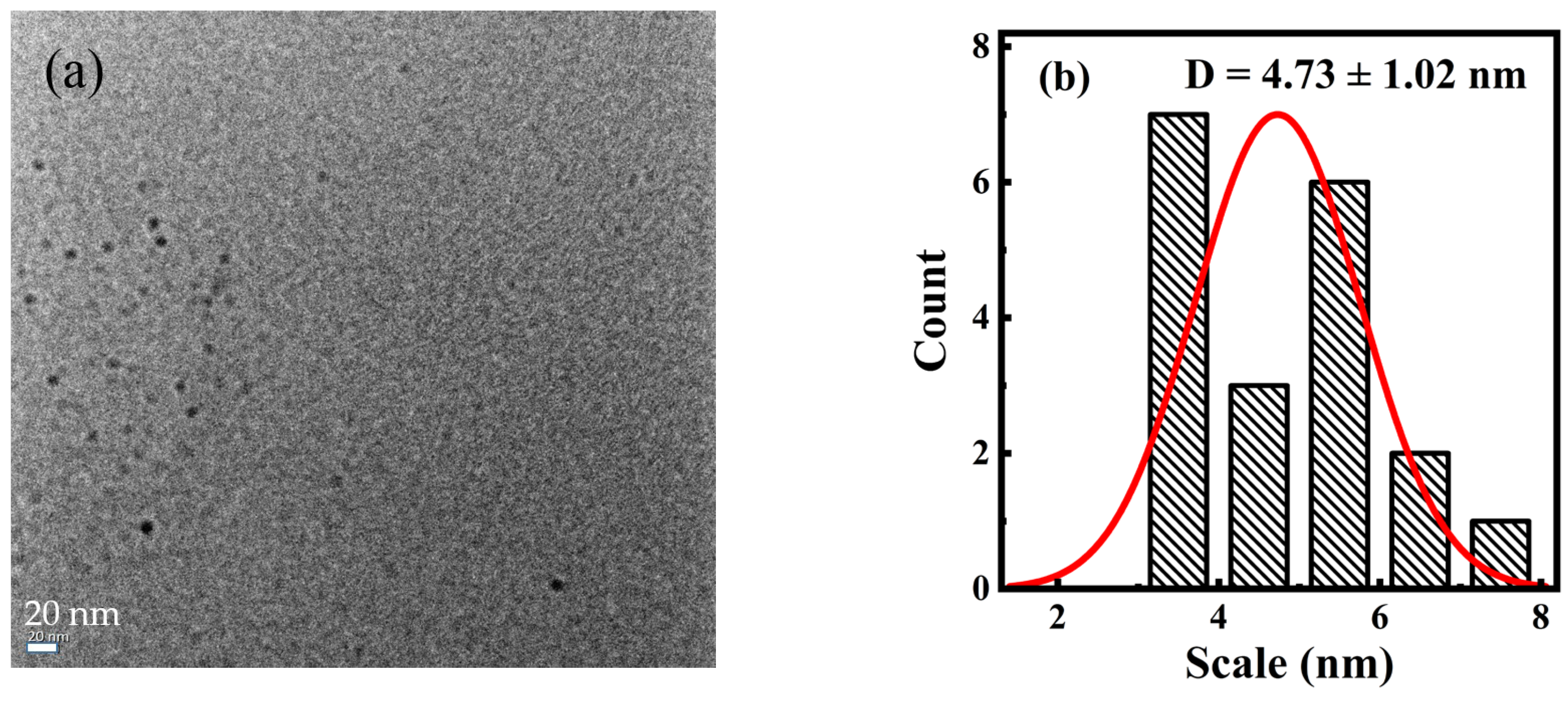
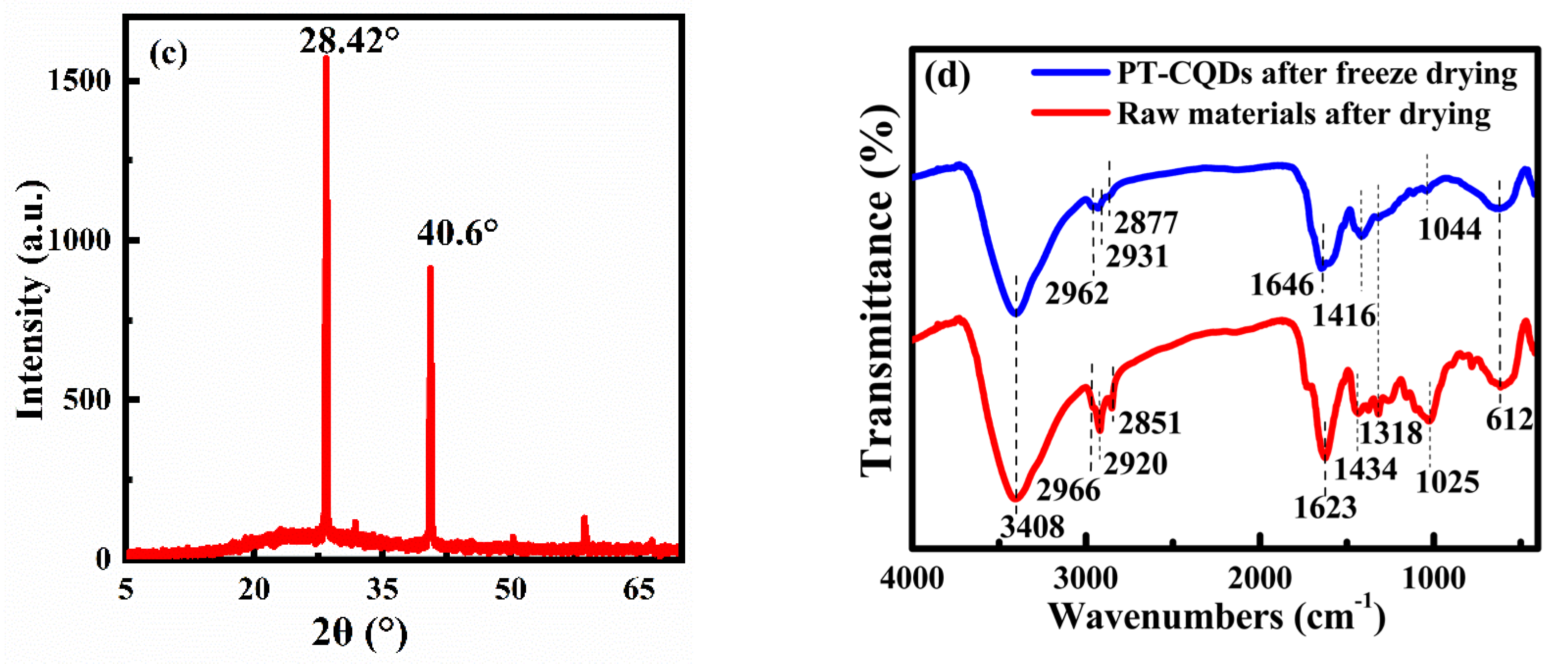
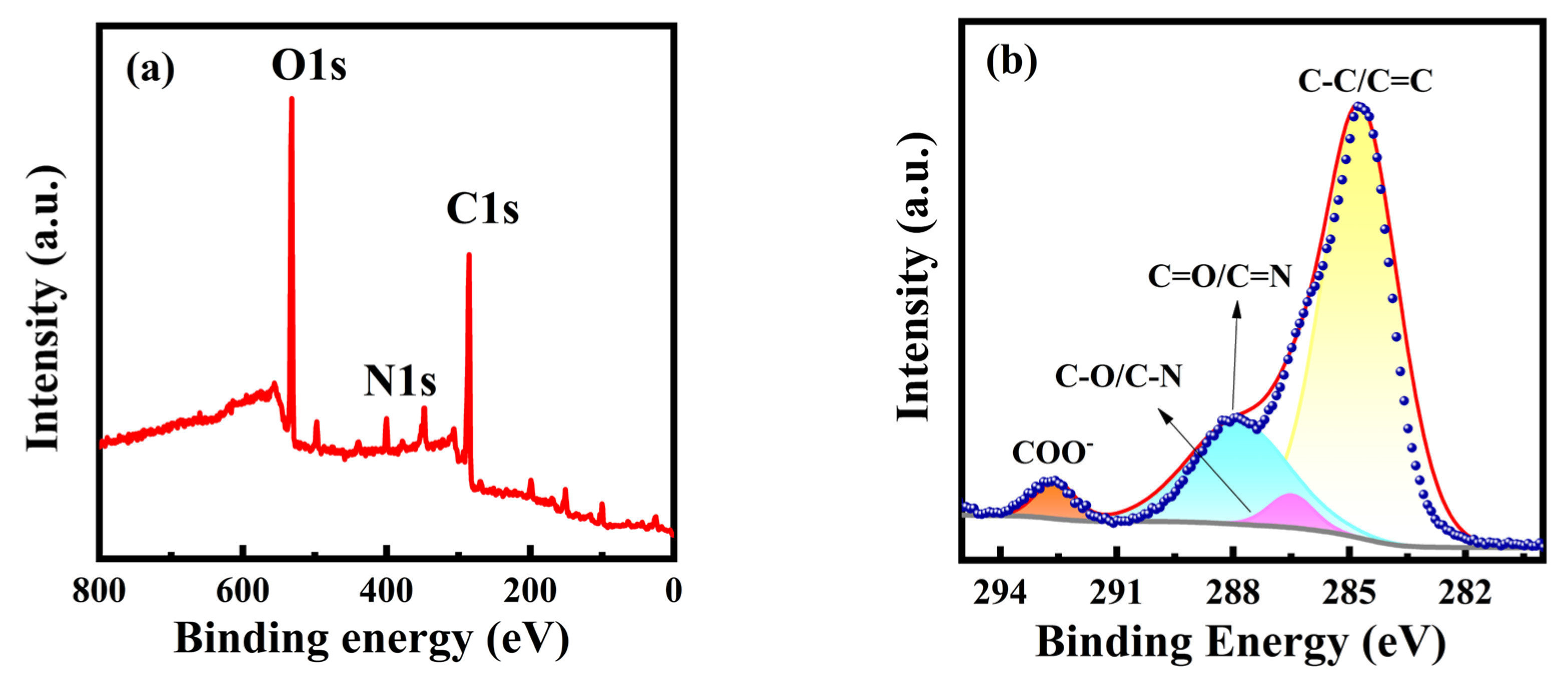

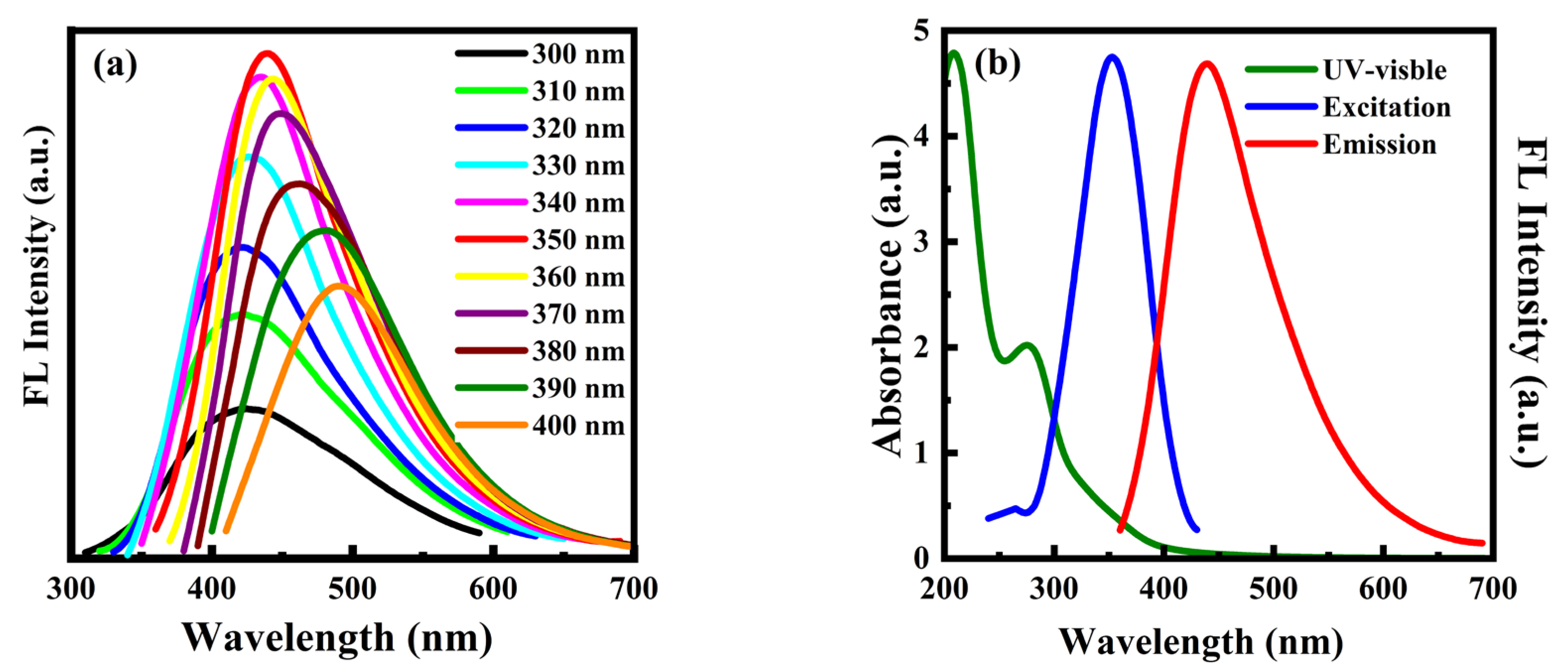
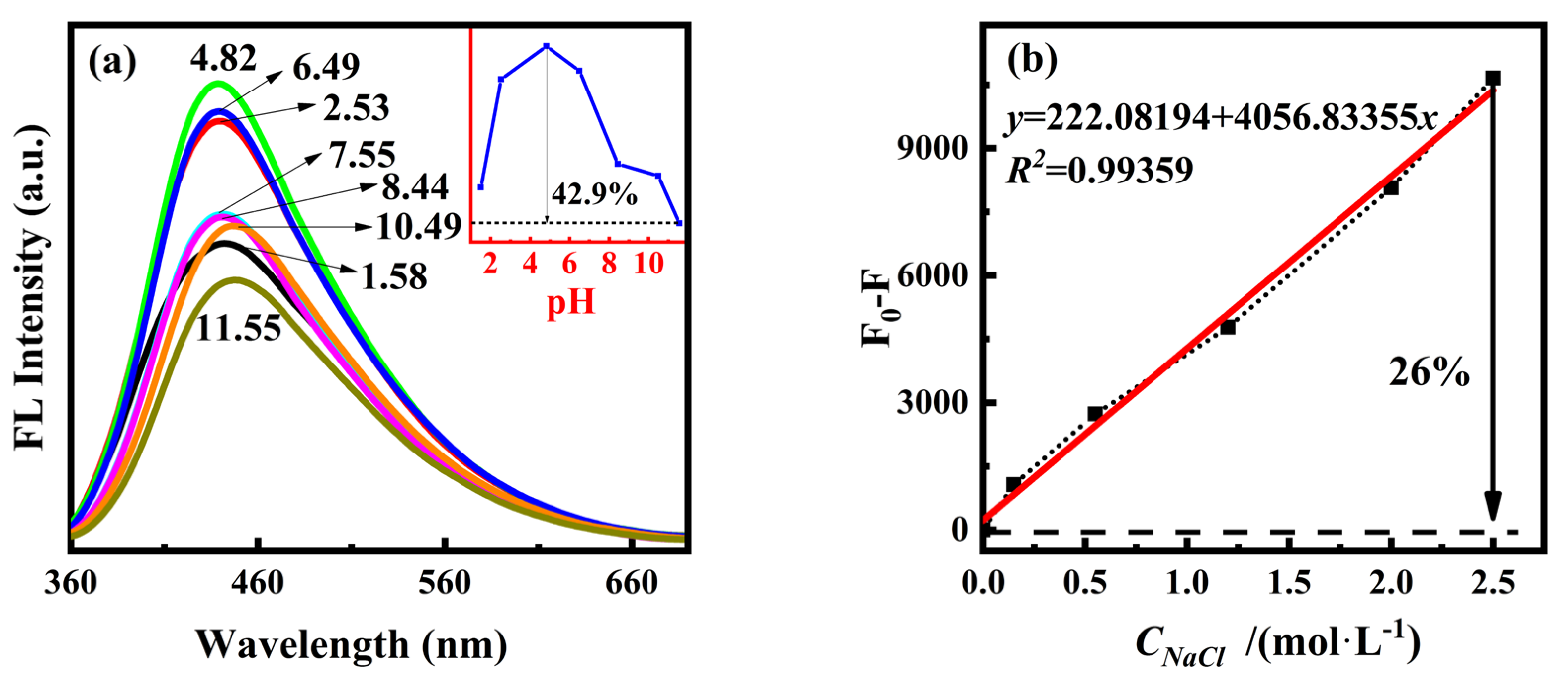




| Sunlight | CIE Coordinates | Ra | CCT (K) | Red (%) | Green (%) | Blue (%) | |
|---|---|---|---|---|---|---|---|
| blank | (0.3529, 0.3618) | 98.8 | 4756 | 18.5 | 75.4 | 6.1 | |
| PT-CQDs | 0.1 wt. % | (0.3805, 0.3854) | 97.9 | 4059 | 20.0 | 74.9 | 5.2 |
| 0.3 wt. % | (0.4151, 0.4107) | 96.2 | 3452 | 21.9 | 74.0 | 4.1 | |
| 0.5 wt. % | (0.4475, 0.4260) | 95.1 | 3000 | 24.2 | 72.7 | 3.2 | |
| 0.7 wt. % | (0.4606, 0.4291) | 95.0 | 2831 | 25.3 | 71.9 | 2.8 | |
Disclaimer/Publisher’s Note: The statements, opinions and data contained in all publications are solely those of the individual author(s) and contributor(s) and not of MDPI and/or the editor(s). MDPI and/or the editor(s) disclaim responsibility for any injury to people or property resulting from any ideas, methods, instructions or products referred to in the content. |
© 2025 by the authors. Licensee MDPI, Basel, Switzerland. This article is an open access article distributed under the terms and conditions of the Creative Commons Attribution (CC BY) license (https://creativecommons.org/licenses/by/4.0/).
Share and Cite
Zhong, L.; Sun, C.; Zhao, X.; Zhao, Q. Dual Roles of Carbon Quantum Dots from Green Carbon Sources: A Fluorescence Sensor for Fe3+ Ions, UV and High-Energy Blue Light Screening. Nanomaterials 2025, 15, 436. https://doi.org/10.3390/nano15060436
Zhong L, Sun C, Zhao X, Zhao Q. Dual Roles of Carbon Quantum Dots from Green Carbon Sources: A Fluorescence Sensor for Fe3+ Ions, UV and High-Energy Blue Light Screening. Nanomaterials. 2025; 15(6):436. https://doi.org/10.3390/nano15060436
Chicago/Turabian StyleZhong, Lina, Chang Sun, Xiaomin Zhao, and Qinghua Zhao. 2025. "Dual Roles of Carbon Quantum Dots from Green Carbon Sources: A Fluorescence Sensor for Fe3+ Ions, UV and High-Energy Blue Light Screening" Nanomaterials 15, no. 6: 436. https://doi.org/10.3390/nano15060436
APA StyleZhong, L., Sun, C., Zhao, X., & Zhao, Q. (2025). Dual Roles of Carbon Quantum Dots from Green Carbon Sources: A Fluorescence Sensor for Fe3+ Ions, UV and High-Energy Blue Light Screening. Nanomaterials, 15(6), 436. https://doi.org/10.3390/nano15060436





